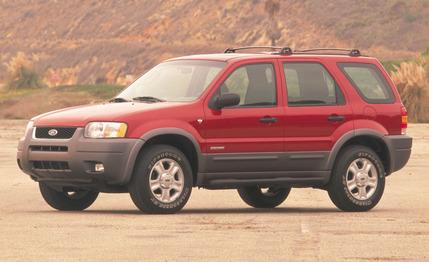 Short Take Road Test
Short Take Road Test
We are nothing if not consistent on the following: When it comes to horsepower, more is invariably better.
Okay, pretty much invariably better. Okay, better most of the time.
Here's the deal. Plentiful power is the easiest element to appreciate in a vehicle's bag of dynamic tricks, and it's also vastly underappreciated as an active-safety feature-a welcome ally during those tense moments when an unnoticed oncoming car suddenly makes a routine passing situation perilous, for example.
But lots of horsepower isn't necessarily an absolute prerequisite for fun-to-drive. The Mazda Miata provides an obvious example of this theorem. And although not quite so obvious, the front-drive, four-cylinder version of the Ford Escape provides another.
To be sure, the power disparity is vast between the Escape's base four-cylinder engine and the optional V-6. The 2.0-liter DOHC 16-valve Zetec four produces 127 horsepower at 5400 rpm and 135 pound-feet of torque at 4500. The 3.0-liter DOHC 24-valve Duratec V-6 churns up 201 horsepower at 5900 rpm and 196 pound-feet at 4700. Applying the old rocket-science calculator, that's a difference of 74 horsepower and 61 pound-feet of torque.
Not to put too fine a point on it, that's a passel of ponies to give away, and it makes a big difference on the stopwatches. The last Escape V-6 we tested ("White Snow and the 11 Dwarfs," March 2001) hit 60 mph in 8.5 seconds and covered the quarter-mile in 16.3 at 84 mph. Despite the advantage of a five-speed manual transmission and some 12.4-percent less mass, the four-cylinder version took a full 11 seconds to reach 60 and 17.9 seconds to hit the quarter-mile timing lights at 79 mph.
Not exactly nosebleed territory. So where, you're asking, is the fun part? The answer lies in the preceding paragraph-less mass, more shifting. The front-drive, four-cylinder Escape tested here is 433 pounds lighter than the all-wheel-drive V-6 XLT tested in our March issue, and its five-speed manual transaxle is something you just can't get with the bigger engine.
Less mass doesn't show to advantage in the acceleration results or, for that matter, on the skidpad, where our tester's 225/70R-15 General Grabber mud and snow tires recorded an indifferent 0.73 g, with howls of protest audible almost all the way to Toledo. But on swoopy back roads, the lighter Escape feels distinctly handier and more playful that its more potent all-wheel-drive counterpart. It's noticeably more eager to attack corners, maintains a more level attitude through a turn, and seems to recover a wink quicker in rapid transitions.
We were also impressed with the precision and feel of this Escape's steering, something else that's attributable to reduced mass.
The other element that makes the four-cylinder Escape an engaging piece to drive is the simple pleasure of selecting gears for oneself, rather than having them chosen by an automatic transmission's microchip. The Escape's five-speed manual isn't what you'd call sports-car crisp, but it provides reasonably precise engagements and, like almost any other manual tranny, enhances the driver's sense of control.
Our formal testing turned up a couple other unpleasant results. Interior noise levels in the four-cylinder Escape were distinctly higher than those recorded in the V-6 version, which isn't particularly quiet, either. And considering the weight disparity, the braking performance of the four-cylinder Escape-182 feet from 70 mph versus 169 feet for the Escape XLT in March-was disappointing. And as an ironic footnote, it's interesting to note that the XLT made that best-in-test stop on Firestone Wilderness HT tires.
Nevertheless, for the driver who's not in a hurry, the four-cylinder, front-drive Escape does have its charms. Particularly at the bottom line: Our four-cylinder XLS weighed in at $20,100, some $3840 less than the comparo-winning XLT.
Now there's a weight disparity that really adds up.